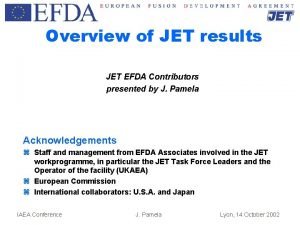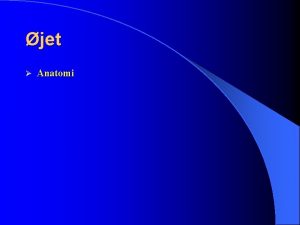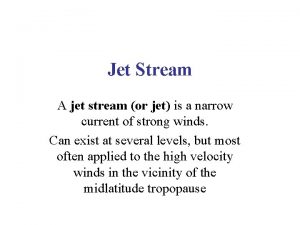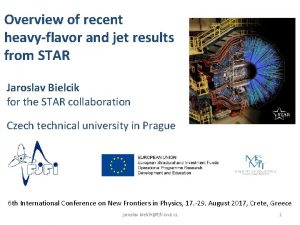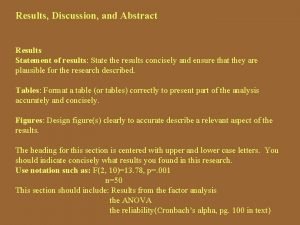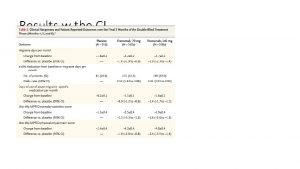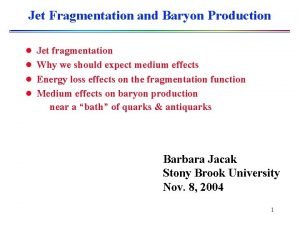Overview of JET results New on JET for




















- Slides: 20

Overview of JET results New on JET for 2006/2007 Divertor for highly shaped (high ) plasmas, upgraded power and enhanced diagnostic capability M. L. Watkins on behalf of JET-EFDA contributors 21 st IAEA Fusion Energy Conference, Chengdu, China 16 L. October M. Watkins 200621 st IAEA Fusion Energy Conference , 16 -21 October 2006 1

ITER Baseline, Hybrid and ITB scenarios Pressure, temperature or density Schematic of tokamak plasma profiles for various operating scenarios Content of talk • q profile control of MHD and transport Hybrid scenario q(R) Normalised radius r/a P /Ploss ~ n ET f(Zeff) ~ E B 2 g(Zeff) Performance improvement by MHD, confinement and impurity control M. L. Watkins • • • #57971 t ~ 4. 6 s Steady State scenario q(R) #58179 t ~ 4. 2 s 1< q min<1. 5 q min 2 shear reversal Major radius [m] Core MHD and fast particles Density peaking and impurity control ELMs and ELM control Material erosion, migration and deposition Summary and conclusions 21 st IAEA Fusion Energy Conference , 16 -21 October 2006 2

Hybrid modes at low q 95~3 reach N~3 Courtesy of E. Joffrin (2006) Figure of merit H 89 b. N/q 952 Hybrid and H-mode in ITER-like shape Hybrid 2006 q 95~3 q 95~4 H-mode 2006 Characteristics of hybrid discharge at q 95= 3. 2 Pulse No: 67940 1. 8 MA/1. 7 T Maintain q 0>1 to avoid sawteet h Hybrid 2003 4 xli PNBI (MW) N qo (MSE) n/n. G Bootstrap current ~ e. p • Hybrid performance similar to H-mode at high q 95~4 • Improved hybrid performance at low q 95~3, slightly better than H-mode with b controlled in real time M. L. Watkins PLH (MW) Ip (MA) No sawteet h H 21 st IAEA Fusion Energy Conference , 16 -21 October 2006 Time (s) 3

Internal Transport Barriers with q 95~5 and 32 MW X. LITAUDON (EX/P 1 -12) TUES am Pulse characteristics 1. 9 MA/3. 1 T Temperature and density profiles 1. 9 MA/3. 1 T During ITB Before ITB Time (s) r/a 2006 ITB discharges extended to lower q 95~5, higher power (32 MW) and high core and edge densities M. L. Watkins 21 st IAEA Fusion Energy Conference , 16 -21 October 2006 4

Control of core MHD (sawteeth) demonstrated J. ONGENA (EX/P 6 -9) FRI am Sawteeth can destabilise Neoclassical Tearing Modes and degrade performance Fast particle stabilised sawteeth destabilised with ICCD Calculated magnetic shear t=23 s Pulse No: 58934 PRF (MW) Magnetic shear Te 0 (ke. V) Pulse No: 58934 Time (s) • Large sawteeth created by ICRF accelerated fast particles • Sawteeth destabilised subsequently, with the application of ICCD F. PORCELLI (EX/7 -4 RA) FRI am Criterion for sawtooth crash Sq=1 > Sq=1 critical W / (Sq=1 t. A) < w*I / 2 M. L. Watkins Increase shear near q=1 r/a • Internal kink mode destabilisation requires critical shear of 0. 2 for this discharge • Critical shear exceeded near q=1 with -900 ICCD phasing (counter-current), explaining observed sawtooth destabilisation 21 st IAEA Fusion Energy Conference , 16 -21 October 2006 5

Observation of fast particle losses from core MHD (sawteeth and tornado modes) Spectrograms showing tornado modes 67673 1. 8 MA/2. 7 T 245 Interferometer (core channel) 240 Sawteeth & tornado modes appear with q 0<1 Energy & pitch angle of lost fast particles from scintillator probe Frequency (k. Hz) 235 230 225 220 245 Magnetics X-mode refl. 240 235 230 225 Between sawteeth During sawtooth • Multichannel crash 220 interferometer (and 16. 8 17. 0 17. 2 17. 4 • Fast particle losses (p, T, D) during X-mode reflectometer) Time (s) tornado phase different signature to enable mode localisation • Core interferometer channel shows those during sawtooth crash tornado modes before sawtooth crash • Modes not seen on edge channel, A. MURARI (IT/P 1 -23) TUES am • Sawteeth losses characteristic of ICRH-accelerated ions (p, D) confirming core localisation M. L. Watkins 21 st IAEA Fusion Energy Conference , 16 -21 October 2006 6

Significant density peaking expected on ITER Merged JET-AUG database on density peaking in ITER Baseline ELMy H-modes H. WEISEN (EX/8 -4) FRI pm • Multi-machine data confirm collisionality, eff, as most relevant parameter for density peaking n 0/<n>vol • Increasing peaking with decreasing eff • Peaking requires anomalous particle pinch, in addition to neutral sources • Scaling of density peaking to ITER with eff as regression variable eff New ITER-like ICRH antenna on JET (installation April 2007) will allow database to be extended to higher power, neutral source free RF heated plasmas M. L. Watkins ne 0/<ne> > 1. 35 • Favourable for fusion output, bootstrap current fraction, density limit Could impact on impurity accumulation 21 st IAEA Fusion Energy Conference , 16 -21 October 2006 7

Impurity density peaking less than neoclassical Measured and predicted density peaking at r/a=0. 55 Neoclassical -RVz/Dz Measurement -RVz/Dz GS 2 w/o Thermodiffusion He, Ne, Ar Ni (LA) 17 18 Time (s) 19 Gz = -Dz nz + nz. Vz R/LNz=RVz/Dz GS 2 Central peaking (r/a=0. 15), albeit less than neoclassical, can still persist M. L. Watkins • Neoclassical theory predicts strong impurity peaking • Transient behaviour of injected and laser ablated impurities shows impurity peaking less than neoclassical Soft X-rays (a. u. ) Pulse No: 66134 C. GIROUD (EX/8 -3) FRI pm • Impurity transport at ITER-like collisionality found to be anomalous • Turbulence theory predicts saturation in peaking as a function of Z at high Z (consistent with measurements) • At low Z prediction of low peaking with thermodiffusion, high peaking without 21 st IAEA Fusion Energy Conference , 16 -21 October 2006 8

Core impurity peaking can be controlled with electron ICRF heating Effect of Minority (ion) heating (MH) and Mode conversion (electron) heating (MC) on Ni transport in low * ELMy H-modes Density profiles Measured convection coefficient M. E. Puiatti Po. P (2006) V (m/s) Normalised Ni profile 58144 58149 Neoclassical x 10 C. GIROUD (EX/8 -3) FRI pm r/a • Ni accumulation is anomalous, and much lower with RF electron heating than with ion heating ITER-like ICRH antenna will extend capability M. L. Watkins r/a • Profile flattening due to outward convection with electron heating Reversal of pinch with e-heating theoretically ascribed to effect of parallel velocity fluctuations with R/LTe driven TEM modes 21 st IAEA Fusion Energy Conference , 16 -21 October 2006 9

Te modulation experiments show ITB as a narrow layer with reduced heat diffusivity P. Mantica PRL (2006) Amplitude and phase of propagating heat wave in plasma with an ITB Pulse No: 62077 200 • Heat wave propagates towards ITB from both sides ITB • Heat wave amplitude (red) damped strongly when wave reaches ITB 150 40 3 ] 100 20 Fast wave Phase [deg] Amplitude [e. V] 60 • Phase (blue) rises when heat wave approaches ITB, showing heat wave slows down 50 PRF [102 MW/m • Modulated RF power deposited either side of ITB (at centre and at R=3. 6 m) Mode conversion b) 0 0 3 3. 1 3. 2 3. 3 3. 4 R[m] M. L. Watkins 3. 5 3. 6 3. 7 • ITB is a narrow layer with reduced heat diffusivity • Indication of region with turbulence stabilised and loss of stiffness 21 st IAEA Fusion Energy Conference , 16 -21 October 2006 10

ITB forms when qmin exists and approaches (rather than reaches) an integer value S. E. SHARAPOV (EX/P 6 -19) FRI am Te at various major radii, R, showing formation of an ITB qmin reaches 2 Te (ke. V) t. AC-t. ITB (s) Pulse No: 61347 Start of ITB formation slightly ahead of Alfvén Cascades (marking qmin= integer) Case number Time (s) • ITB formation starts before q=2 surface enters plasma M. L. Watkins • Alfvén cascades seen simultaneously on microwave interferometer, O-mode interferometer, X-mode reflectometer (not shown), and magnetic probe 21 st IAEA Fusion Energy Conference , 16 -21 October 2006 11

Measured poloidal velocity in ITB much higher than neoclassical estimates T. TALA (EX/P 3 -16) WED pm Poloidal velocity from charge exchange, during ITB formation Ti (ke. V) V (km/s) Ion temperature profiles during ITB formation Rmid (m) • ITB layer with steep temperature gradient Rmid (m) K. Crombie PRL (2006) • Measured poloidal velocity in ITB layer (60 km/s) highly anomalous, far higher than neoclassical (~5 -10 km/s) • Er and Ex. B shear much larger with measured Vq • Weiland model with measured Vq (rather than neoclassical) matches experiment better M. L. Watkins 21 st IAEA Fusion Energy Conference , 16 -21 October 2006 12

ELMs can cause damage and must be controlled R. A. PITTS (EX/3 -1) WED pm Type I ELMs on ITER could expel transiently 3 -8% of 350 MJ stored energy 0. 6 -3. 4 MJm-2 New fast IR camera #66560, 5. 548 s 150 k. J ELMs Type I ELMs on JET 1 MJ on 0 • Filamentary power deposition divertor 2500 C • Clear field aligned structures M. L. Watkins 0. 2 MJm-2 Type I ELM energy deposition in the JET Mark. II SRP gas box divertor • ELM energy depositon on inner divertor ~ 2 x outer divertor • Load between ELMs on outer divertor • May relax outer divertor load on ITER 21 st IAEA Fusion Energy Conference , 16 -21 October 2006 13

Passive ELM control with high frequency, small Type I ELMs at low ne ( *), high and q 95~4 -5 R (m) ELM frequency vs. q 95 More highly shaped plasma at higher q 95 “convective” ELMs • At high small, high frequency Type I ELMs seen at high q 95 • Indication of threshold at q 95~ 4. 2 Cost: high q 95 low t. E for given B Combine with improved core for improved confinement M. L. Watkins Courtesy of A. LOARTE (2006) A. LOARTE (IT/P 1 -14) TUES am TELM/Tped vs. q 95 TELM/Tped ELM frequency (Hz) Height (m ) High and low configurations, exploring small Type I ELMs q 95 • TELM/Tped decreases suddenly at q 95 ~ 4. 2 and f. ELM increases • Small ELMs ( WELM/Wped < 5%) obtained with low * at high q 95 • Not seen at low 21 st IAEA Fusion Energy Conference , 16 -21 October 2006 14

Passive ELM control by plasma shaping, similar to ASDEX Upgrade with QDN Previous JET studies gave only transient Type II behaviour. Refined shape leads to stationary benign ELM regime with good confinement 1019 m-3 2. 5 <ne> nped also constant Turbulent magnetic fluctuations coincide with D bursts Magnetic configurations in new and previous JET studies Blue: New #66476 67911 0 1 MJ Courtesy of R. J. Buttery et al (2006) D H 98 0. 95 Red: Previous experiment #62430 Wtot 0 Magnetics (a. u. ) 1 ms D 28 29 30 31 32 Time (s) • ELM behaviour constant over pulse • Very fine scale activity - distinct ELMs almost indistinguishable M. L. Watkins U L k sep (mm) 62430 0. 5 0. 37 1. 72 ≤ 10 66476 0. 34 0. 4 1. 79 ≈6 21 st IAEA Fusion Energy Conference , 16 -21 October 2006 15

Active ELM control at >30 MW with an ITB and neon seeding X. LITAUDON (EX/P 1 -12) TUES am Pulse characteristics Pulse No: 67869 1. 9 MA/3. 1 T D. MOREAU (EX/P 1 -2) TUES am Divertor radiation N JET AT database quasi-stationary ( / E>10) pulses at high N and high Z (m) Between ELMs (no neon seeding) Z (m) With neon seeding Target for JET-EP 2 AT regimes with 45 MW planned power upgrades R (m) Time (s) • ELM control with Neon (4 -8 s) Prad~17 MW dithering H-mode • B~3. 1 T, I~1. 9 MA, q 95~5 PNBI~19. 5 MW, PICRH~8 MW, PLHCD~3. 2 MW Wdia~5. 6 MJ, b. N~2 M. L. Watkins 21 st IAEA Fusion Energy Conference , 16 -21 October 2006 16

Material erosion, migration and deposition are key to fuel retention A. KIRSCHNER (EX/3 -5) WED pm Measurement Edge 2 D modelling Tile 1 Location 6. 1% Tile 3 13 CH 10. 9% 0. 5% 3. 8% 4 Tile 7 2. 5% Tile 5 Tile 4 SRP Tile 6 • 13 CH • Inner divertor • Deposition dominated • Outer divertor vertical tiles • Erosion dominated • Heavy erosion of W stripe (200 mm suggested for ITER like wall) • Outer divertor base plate • Deposition dominated Tile 8 2. 7% injected in reproducible ELMy H-modes • Quartz Microbalance measurements • 3 mm thick W stripe on Tiles 1 and 8 • Post mortem analysis of tiles 4 Behaviour • Remote areas • Material transport sensitive to magnetic configuration • Complex migration pattern • Fuel retention in divertor (mainly due to co-deposition) is 2. 7% of input (see also T. LOARER (EX/3 -6) WED pm) • Main chamber, tile gaps and SRP contributions not included (see also M. RUBEL (EX/P 4 -24) THU am) M. L. Watkins 21 st IAEA Fusion Energy Conference , 16 -21 October 2006 17

Summary and conclusions (1) New results on Hybrid • Hybrid performance similar to H-mode at q 95~4 and slightly better at q 95~3 with N~3 and ~75% Greenwald density New results on ITB • ITBs extended to lower q 95 (5), higher power (32 MW), high edge and core densities and good ELM control with neon injection Density peaking and impurity control Core MHD and fast particles M. L. Watkins • eff* most important parameter for density peaking • Peaking factor >1. 35 expected for ITER • Impurity transport anomalous, with mild accumulation which can be controlled with electron heating ITER-like ICRH Antenna to extend density peaking and impurity control to higher power / lower fuelling • Core MHD (sawteeth and tornado modes) expel fast particles ITER-like ICRH antenna to extend control capability for fast particle MHD and transport losses by localised current drive 21 st IAEA Fusion Energy Conference , 16 -21 October 2006 18

Summary and conclusions (2) • Non-stiff profiles with reduced diffusivity in ITB layer • Form slightly ahead of qmin reaching integer value • May be sustained by high Ex. B shear with observed poloidal velocity significantly greater than neoclassical Potential access to ITER regime with planned power upgrades (Ibootstrap and n ET increasing together) ITB physics New results on passive and active ELM control Material erosion, deposition and migration • • ELMs must be ameliorated for ITER Passive control at high and q 95 (small high frequency Type I) Passive control with shaping (similar to Type II on AUG) Active control with Neon injection (ITB with Type III? ) • Erosion of outer divertor, strong parallel flow in SOL, deposition on inner divertor; sensitive to magnetic configuration Fuel retention at 3% on JET under C-dominated conditions Need to test ITER wall materials under high performance conditions, as foreseen in longer-term JET programme in support of ITER (Beryllium wall, Tungsten divertor, 45 MW heating power) M. L. Watkins 21 st IAEA Fusion Energy Conference , 16 -21 October 2006 19

EFDA-JET contributions to this conference MONDAY M. WATKINS AM (OV/1 -3) TUESDAY THURSDAY M. RUBEL AM AM (EX/P 4 -24) THURSDAY PM F. CRISANTI* (EX/P 1 -1) D. MOREAU (EX/P 1 -2) R. V. BUDNY* (EX/P 1 -5) X. LITAUDON (EX/P 1 -12) F. PORCELLI (EX/7 -4 RA) C. F. MAGGI* (IT/P 1 -6) J. ONGENA (EX/P 6 -9) A. LOARTE (IT/P 1 -14) S. E. SHARAPOV (EX/P 6 -19) T. HENDER* (IT/P 1 -21) T. A. K. HELLSTEN* (EX/P 6 -21) A. MURARI (IT/P 1 -23) V. NAULIN* (TH/P 6 -22) WEDNESDAY H. MAIER* H. L. BERK* FRIDAY AM (IT/P 2 -4) WEDNESDAY (TH/3 -1) PM AM FRIDAY PM C. GIROUD (EX/8 -3) R. A. PITTS (EX/3 -1) H. WEISEN (EX/8 -4) A. KIRSCHNER (EX/3 -5) T. C. HENDER* (EX/8 -18) T. LOARER (EX/3 -6) V. A. YAVORSKIJ * (TH/P 6 -7) D. Mc. DONALD* (EX/P 3 -5) T. TALA (EX/P 3 -16) SATURDAY * Not referred to in presentation OV/1 -3 M. L. Watkins V. PARAIL* AM (TH/P 8 -5) 21 st IAEA Fusion Energy Conference , 16 -21 October 2006 20
 Yelvington jet aviation jet fuel
Yelvington jet aviation jet fuel Nj board of law examiners
Nj board of law examiners Fspos
Fspos Novell typiska drag
Novell typiska drag Nationell inriktning för artificiell intelligens
Nationell inriktning för artificiell intelligens Ekologiskt fotavtryck
Ekologiskt fotavtryck Varför kallas perioden 1918-1939 för mellankrigstiden?
Varför kallas perioden 1918-1939 för mellankrigstiden? En lathund för arbete med kontinuitetshantering
En lathund för arbete med kontinuitetshantering Kassaregister ideell förening
Kassaregister ideell förening Tidbok yrkesförare
Tidbok yrkesförare Sura för anatom
Sura för anatom Förklara densitet för barn
Förklara densitet för barn Datorkunskap för nybörjare
Datorkunskap för nybörjare Boverket ka
Boverket ka Debattartikel struktur
Debattartikel struktur Autokratiskt ledarskap
Autokratiskt ledarskap Nyckelkompetenser för livslångt lärande
Nyckelkompetenser för livslångt lärande Påbyggnader för flakfordon
Påbyggnader för flakfordon Kraft per area
Kraft per area Offentlig förvaltning
Offentlig förvaltning Kyssande vind analys
Kyssande vind analys





















